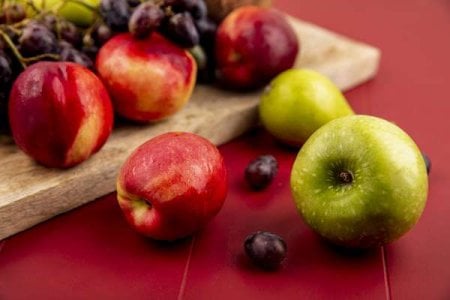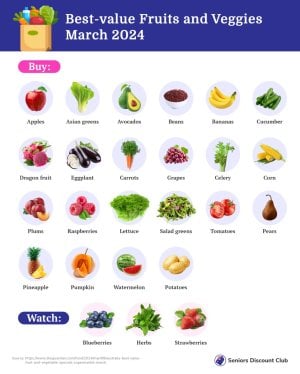Slash your grocery bills this March: Here are the most budget-friendly fruits and vegetables to buy
As autumn settles over Australia, a shift in house budgets is on the horizon, with different fruits and vegetables coming into their prime season.
Before you begin assembling your shopping list and plan your meals for March, let’s dive into some insider advice over which fruits and vegetables give you the value for your dollar and which ones to shy away from.
Pat Senserrick, the seasoned proprietor of Senserricks Fruit and Flowers in northwest Melbourne, suggested buying apples, grapes, and raspberries this season.
Autumn, while being a transitional season, might not be the best one when it comes to fresh produce, but it does bring some saver deals for the smart shopper.
Markets offer a wider canvas of fresh produce compared to supermarkets and are often competitively priced.
Senserrick says grapes are coming into their full season, especially the red and Thompson seedless varieties.
The 'crunchy pop', a lesser-known red seedless variety that some supermarkets might not carry, is his personal favourite for this season.
Treat your taste buds to these flavours at about $5 to $7 per kilo.
Apples lead the pack for dessert ideas, with new season prices ranging from $3 to $6 per kilo.
Royal gala apples have already hit the supermarket shelves at approximately $3.90 a kilo, with their pink lady and granny smith counterparts following at around $4.50 a kilo.
Considering these low prices, you could try making the Easy Apple Cake or Apple Crumble Slice recipes shared by member @Suzanne rose.
Pears have also started appearing in markets ranging between $3 and $5 per kilo—perfect to try a spin on this Caramelised Pear, Rum & Coconut Crumble recipe.
Berries are all the rage this time around, with blackberries costing a mere $3.50 a punnet.
In contrast, raspberries are deemed an even better deal, found at as low as $3 a punnet in supermarkets.
To put these to good use, test your culinary skills with this delicious Raspberry Muffin recipe by member @Penny4.
However, strawberries are facing some challenging growth conditions, leading to unusually smaller sizes than the ones we’re accustomed to.
Nevertheless, as far as flavour goes, Senserrick assured there’s no significant difference.
At about $3.50 a punnet in supermarkets, they might not give you the typical appearance but will still manage to tantalise your taste buds.
On the pricier side, blueberries seem to be rarer and costlier than usual at more than $4 a punnet.
Dragon fruit has notably gained traction in the market, backed by a steady supply. While it isn't the cheapest, it definitely fits the bill for those intrigued by uncommon fruits.
While retailing between $4 to $8 apiece, it brings a certain exotic flair to your fruit basket. It is conveniently consumed straight out of its skin, akin to how one eats a kiwifruit, or it can be sliced and served with a generous drizzle of lime.
Among the melons, watermelon is the economical choice right now, priced at roughly $2 per kilo.
Rock melon and honeydew are being deemed pricier and not optimally fresh, and, as Senserrick recommends, they should be skipped.
As autumn takes shape, pineapples have started coming down in price, now costing anywhere between $4 to $6 per piece.
Meanwhile, it’s bad news for cauliflower, broccoli, and cabbage lovers, as these cruciferous veggies have seen a price hike this month.
Supply shortages have led to nearly half a cabbage in a supermarket costing about $4 or more, while broccoli and cauliflower have breached the $7 per kilo mark.
Beans and capsicums are tipping the price scale at the upper end, priced at no less than $10 a kilo.
Despite these hiked prices, some solace can be found in the fact that salad greens remain excellent value.
Lettuce, despite the rainfall, is still between $2 and $2.50 a head, with continental cucumbers and corn at about $1.50 apiece.
To add to this, avocados are retailing at roughly $1.70 each, making them both nutritious and affordable.
Stepping up into the autumn kitchen domain, roasting is all set to make a comeback.
As the temperatures begin to drop, hearty vegetables like potatoes, pumpkin, and sweet potatoes, suited to slow roasting and comforting meals, are seen filling shoppers’ baskets.
These are seeing consistent pricing, as are carrots which seemingly never go through pricing dynamics.
The key takeaway for budget-conscious buyers? Go for apples, pears, grapes, lettuce, avocados, and potatoes.
Be mindful of pricier options like blueberries, broccoli, cabbage, cauliflower, capsicums, rock melon, and honeydew.
We have compiled this list for you:
Please note that as of publication, the prices of these fruits and vegetables may differ at both Coles and Woolworths.

What do you think of this list, members? Do you have more recipes for these affordable fruits and veggies? Share them in the comments below!
Before you begin assembling your shopping list and plan your meals for March, let’s dive into some insider advice over which fruits and vegetables give you the value for your dollar and which ones to shy away from.
Pat Senserrick, the seasoned proprietor of Senserricks Fruit and Flowers in northwest Melbourne, suggested buying apples, grapes, and raspberries this season.
Autumn, while being a transitional season, might not be the best one when it comes to fresh produce, but it does bring some saver deals for the smart shopper.
Markets offer a wider canvas of fresh produce compared to supermarkets and are often competitively priced.
Senserrick says grapes are coming into their full season, especially the red and Thompson seedless varieties.
The 'crunchy pop', a lesser-known red seedless variety that some supermarkets might not carry, is his personal favourite for this season.
Treat your taste buds to these flavours at about $5 to $7 per kilo.
Apples lead the pack for dessert ideas, with new season prices ranging from $3 to $6 per kilo.
Royal gala apples have already hit the supermarket shelves at approximately $3.90 a kilo, with their pink lady and granny smith counterparts following at around $4.50 a kilo.
Considering these low prices, you could try making the Easy Apple Cake or Apple Crumble Slice recipes shared by member @Suzanne rose.
Pears have also started appearing in markets ranging between $3 and $5 per kilo—perfect to try a spin on this Caramelised Pear, Rum & Coconut Crumble recipe.
Berries are all the rage this time around, with blackberries costing a mere $3.50 a punnet.
In contrast, raspberries are deemed an even better deal, found at as low as $3 a punnet in supermarkets.
To put these to good use, test your culinary skills with this delicious Raspberry Muffin recipe by member @Penny4.
However, strawberries are facing some challenging growth conditions, leading to unusually smaller sizes than the ones we’re accustomed to.
Nevertheless, as far as flavour goes, Senserrick assured there’s no significant difference.
At about $3.50 a punnet in supermarkets, they might not give you the typical appearance but will still manage to tantalise your taste buds.
On the pricier side, blueberries seem to be rarer and costlier than usual at more than $4 a punnet.
Dragon fruit has notably gained traction in the market, backed by a steady supply. While it isn't the cheapest, it definitely fits the bill for those intrigued by uncommon fruits.
While retailing between $4 to $8 apiece, it brings a certain exotic flair to your fruit basket. It is conveniently consumed straight out of its skin, akin to how one eats a kiwifruit, or it can be sliced and served with a generous drizzle of lime.
Among the melons, watermelon is the economical choice right now, priced at roughly $2 per kilo.
Rock melon and honeydew are being deemed pricier and not optimally fresh, and, as Senserrick recommends, they should be skipped.
As autumn takes shape, pineapples have started coming down in price, now costing anywhere between $4 to $6 per piece.
Meanwhile, it’s bad news for cauliflower, broccoli, and cabbage lovers, as these cruciferous veggies have seen a price hike this month.
Supply shortages have led to nearly half a cabbage in a supermarket costing about $4 or more, while broccoli and cauliflower have breached the $7 per kilo mark.
Beans and capsicums are tipping the price scale at the upper end, priced at no less than $10 a kilo.
Despite these hiked prices, some solace can be found in the fact that salad greens remain excellent value.
Lettuce, despite the rainfall, is still between $2 and $2.50 a head, with continental cucumbers and corn at about $1.50 apiece.
To add to this, avocados are retailing at roughly $1.70 each, making them both nutritious and affordable.
Stepping up into the autumn kitchen domain, roasting is all set to make a comeback.
As the temperatures begin to drop, hearty vegetables like potatoes, pumpkin, and sweet potatoes, suited to slow roasting and comforting meals, are seen filling shoppers’ baskets.
These are seeing consistent pricing, as are carrots which seemingly never go through pricing dynamics.
The key takeaway for budget-conscious buyers? Go for apples, pears, grapes, lettuce, avocados, and potatoes.
Be mindful of pricier options like blueberries, broccoli, cabbage, cauliflower, capsicums, rock melon, and honeydew.
We have compiled this list for you:
Please note that as of publication, the prices of these fruits and vegetables may differ at both Coles and Woolworths.
Key Takeaways
- Markets tend to have more variety and better prices on fruit and vegetables compared to supermarkets, according to a Melbourne market vendor.
- Apples, grapes, and raspberries are noted as being of the best value at the start of autumn.
- Prices for cabbages, beans, cauliflower, and broccoli have increased due to weather impacting supply, while salad greens remain very good value despite the rain.
- Consumers are advised to buy seasonal produce such as apples, pears, and dragon fruit for value and to be cautious when purchasing more expensive items like capsicums and rock melons.
Last edited:











